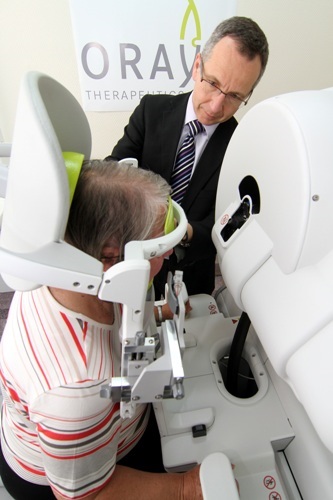Aug 20 2014
SHEFFIELD Teaching Hospitals NHS Foundation Trust has become the first NHS hospital in the UK to start offering its patients a new non-invasive treatment for wet age-related macular degeneration (wet AMD).

Royal Hallamshire Hospital eye doctor Mr Christopher Brand with Sheila Brooks, one of the first patients to benefit from Oraya TherapyTM
Wet AMD affects 250,000 people in the UK alone, and is the leading cause of blindness in people over 65 in the western world. If left untreated it can quickly lead to loss of central vision. Current treatments involve regular anti-VEGF injections into the eye – but these can be uncomfortable for patients and involve repeated hospital trips.
Now, eye specialists at Sheffield’s Royal Hallamshire Hospital have begun treating some appropriate patients with wet AMD using Oraya TherapyTM, which delivers painless, highly targeted, low-energy X-rays to the eye. The low-energy X-rays are delivered by a non-invasive robotic device called IRay® Radiotherapy System which uses low-level radiation, similar to a dental X-ray. The treatment works by controlling or stopping leakage in the eyes by focusing the X-ray beams on the back of the eyes, which reduces scarring and improves vision by drying up the leakage. The treatment is given once and used in combination with anti-VEGF injections. Patients treated with the IRay device sit at the machine with their chin on a chin rest.
A European clinical trial has shown that Oraya TherapyTM can reduce the number of anti-VEGF injections patients with wet AMD need by 45 per cent. The procedure takes a matter of minutes, and is undertaken by a trained ophthalmologist, who have the skill and expertise to identify which patients with wet AMD would benefit from the treatment.
Mr Christopher Brand, Consultant Ophthalmologist at the Royal Hallamshire Hospital, said:
Wet AMD is an aggressive form of one of the most common eye diseases, and treatment can often be uncomfortable, with patients having to have regular injections on a monthly, or two-monthly basis, or in perpetuity.
So far we have treated a small number of patients using Oraya TherapyTM and the prospect of being able to reduce the number of injections that patients have to endure is greatly welcomed. Current treatments can cost the NHS upwards of £700 per injection, so not only should Oraya TherapyTM benefit patients but it will also be more cost effective. Injections are still a valuable option for the treatment of Wet AMD for many patients as the new treatment will not be appropriate for all patients.
Sheila Brooks, an 83 year old retired sewing machine operator from Sheffield was one of the first patients to be treated with Oraya TherapyTM at the Royal Hallamshire Hospital. “I was diagnosed with Wet AMD in my left eye three years ago and since then I have had nine injections in my left eye. I don’t like the injections, nor the regular 28 mile round trip to the hospital, so the x-ray therapy was very appealing to me.”
There are two main types of AMD, called ‘dry AMD’ and ‘wet AMD’. Wet AMD is more serious and without treatment, vision can deteriorate within days. There is currently no treatment for dry AMD.